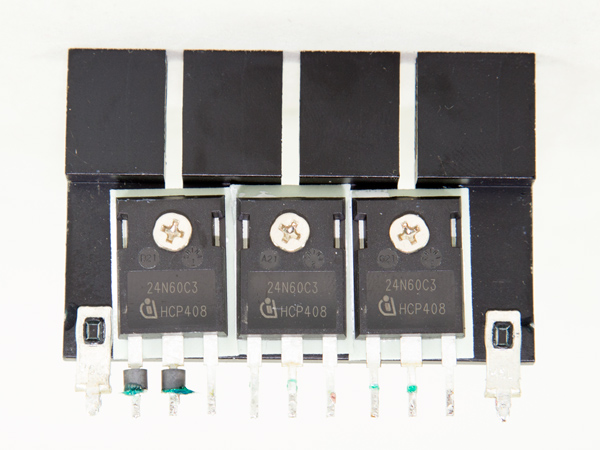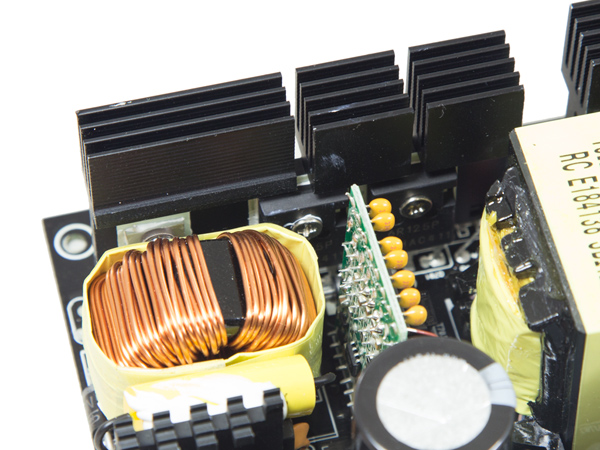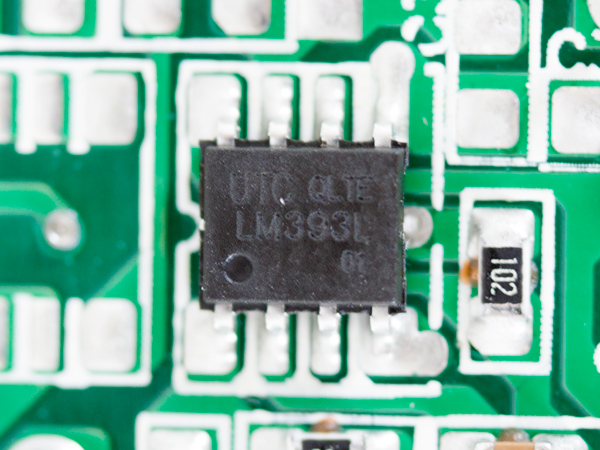Rosewill Photon-1200 PSU Review
Today, we evaluate Rosewill's Photon-1200, manufactured by Sirfa, featuring fully modular cabling, Gold-rated efficiency and a high watt-per-dollar ratio.
Why you can trust Tom's Hardware
A Look Inside And Component Analysis
Parts Description
Our main tools for disassembling PSUs are a Thermaltronics soldering and rework station and a Hakko 808 desoldering gun.
| Primary Side | |
|---|---|
| Transient Filter | 4x Y caps, 2x X caps, 2x CM chokes, 1x MOV, 1x CM02X |
| Inrush Protection | - |
| Bridge Rectifier(s) | 2x GBJ2506 (600V, 25A @ 100 °C) |
| APFC MOSFETs | 3x Infineon SPW24N60C3 (650V, 15.4A @ 100°C, 0.16Ohm ) |
| APFC Boost Diode | 2x CREE C3D08060A (600V, 8A @ 152 °C) |
| Hold-up Cap(s) | 2x Rubycon (400V, 470uF each or 940uF combined, 2000h @ 105 °C, MXH) |
| Main Switchers | 2x Infineon 60R125CP (650V, 16A @ 100°C, 0.125Ohm) |
| APFC / Switching Controller | Champion CM6800 |
| Topology | Primary side: Double Forward Secondary side: Synchronous Rectification & DC-DC converters |
| OEM | Sirfa / High Power |
| Secondary Side | |
| +12V MOSFETs | 8x Infineon IPP034NE7N3 G (75V, 100A @ 100 °C, 3.4 mohm) |
| 5V & 3.3V | DC-DC Converters: 6x Infineon IPD060N03L G (30V, 50A @ 100 °C, 6 mohm) PWM Controller:1x APW7159 |
| Filtering Capacitors | Electrolytics: Nippon Chemi-Con (105 °C, KY, KZE) Polymers: Nippon Chemi-Con |
| Supervisor IC | SITI PS223 (OVP, UVP, OCP, SCP, OTP ) |
| Fan Model | Globe Fan RL4Z B1352512HH (12V, 0.45A, 129.76 CFM, 1800 RPM, 33.9 dB[A], Double Ball-Bearing) |
| 5VSB Circuit | |
| Rectifier | 1x PFR 30L45CT |
| Standby PWM Controller | Power Integrations TOP256EN (86W @ Open Frame) |





The Photon-1200 is made by Sirfa, an OEM that’s mostly experienced in creating budget PSUs. However, Sirfa does have some interesting high-end platforms in its portfolio. The Photon-1200's internals are identical to the High Power Astro GD 1200W, which makes sense since both PSUs are based on Sirfa's HPJ platform. In the primary side, Sirfa doesn't use an LLC resonant converter, so we don't expect this unit to be able to compete in the efficiency section (at least not compared to PSUs featuring LLC resonant converters). In the secondary side, a synchronous design is used where active components rectify all rails, which is typical for this category.




The first part of the EMI/transient filter is on the AC receptacle and, in this case, consists of one X and two Y caps. On the X cap, we noticed a CM02X IC that blocks current through the cap's discharge resistor when AC voltage is connected to avoid energy losses on the bleeding resistor. The EMI filter continues on the main PCB with one X and two Y caps, along with a pair of CM chokes and an MOV. The latter is partially hidden by the PFC input capacitor.



Both bridge rectifiers, a pair of GBJ2506s, are bolted on a small, dedicated heat sink. The amount of current that these bridge rectifiers can handle is huge, easily covering the needs of the Photon-1200.







Three Infineon SPW24N60C3s are used in the APFC converter, along with a pair of CREE C3D08060A boost diodes. In addition, the bulk caps are provided by Rubycon, and their combined capacity is 940uF.





The main switchers are a pair of Infineon 60R125CP FETs. The combo PFC/PWM controller, a Champion CM6800 IC, is installed on a small daughterboard. It's commonly used in Bronze-rated PSUs and lower. We don't have high expectations when it comes to the efficiency levels that this platform will provide, given the plain design and outdated PFC/PWM controller it uses.








Two small heat sinks in the secondary side hold all FETs that regulate the +12V rail, which are eight Infineon IPP034NE7N3 G. The DC-DC converters that handle the minor rails are installed directly on the modular board in order to save some losses on power transfer cables. Each of the aforementioned converters uses four Infineon IPD060N03L G, and the common PWM controller is an Anpec APW7159.
Get Tom's Hardware's best news and in-depth reviews, straight to your inbox.



All filtering capacitors in the secondary side, both electrolytic and polymer, are Japanese, provided by Nippon Chemi-Con. Although this is a low-cost Gold unit, Rosewill and Sirfa decided wisely to use high-quality capacitors to increase the PSU's reliability. On the front side of the modular board, several polymer caps by Chemi-Con are used for ripple filtering, while some of them are utilized by the DC-DC converters.


The standby PWM controller is a Power Integrations TOP256EN, which can provide up to 86W with an open-frame design. The SBR that rectifies the 5VSB rail is a PFR 30L45CT.
Housekeeping is done by a SITI PS223, one of the very few relevant ICs that supports OTP (over-temperature protection) out of the box. In addition, this IC supports OCP (over-current protection) for up to two +12V rails. The Photon-1200, however, has only one.







Soldering quality isn't among the best we have seen, but it's good overall, especially for a budget, high-capacity unit. On the solder side of the main PCB we also spotted a Unisonic LM393L dual differential comparator.
The cooling fan is provided by Globe Fan (model number RL4Z B1352512HH, 12V, 0.45A, 129.76 CFM, 1800 RPM, 33.9 dB[A]). It uses double ball-bearings, so it will last for quite a long time. This fan is powerful, capable of pushing a significant amount of air. However, its profile is aggressive. Because this supply's efficiency isn't great, thermal loads inside the PSU are increased, causing the fan to spin faster.
Current page: A Look Inside And Component Analysis
Prev Page Packaging, Contents, Exterior And Cabling Next Page Load Regulation, Hold-Up Time And Inrush Current
Aris Mpitziopoulos is a contributing editor at Tom's Hardware, covering PSUs.
-
MasterMace Sirfa has produced too many poor units in the past to get any leeway or benefit of the doubt. It failed 80 Plus Gold in the hotbox at 100% load.Reply -
boller I have a good perspective on that ripple thing: just finished repairs of a PC power supply and when I was measuring ripple I found it was out of whack (300 mV pp). After some investigation I found out that measuring ripple is a tricky thing. Tom's description on how they do it is very incomplete. Eevblog guy spent an entire episode on ripple. In my case I had to do this: limit oscilloscope bandwidth 20 MHz, instead of the grounding clip use that spring attachment and measure loaded PSU at the last cap before leads. Ripple went down from 300 to 48 mV pp.Reply -
Aris_Mp First of all you don't just hook a scope on a PSU's output and measure ripple else you will catch huge spikes, like in your case, which will totally alter the measured result.Reply
Secondly most users aren't interested on how I do things (and even if I elaborated on all the procedures I follow only a fraction of them would understand them) but about the final result. For me the most important is to explain what ripple is and how it can affect the components of a system.
Thirdly. You don't have to watch Dave to see how ripple is measured properly. You can check on the ATX spec which includes the ripple measurement procedure. I follow all guidelines of the ATX spec so if you need to see how I measure ripple or load regulation just take a look at them. In any case the following scheme will show you how to measure ripple on a PSU.
-
boller No need to be defensive, I was just pointing out that your _description_ is incomplete, not that you do it wrong. Although it would be nice for you to place a note over there saying that actual procedure involves some additional caps and an honest to god differential probe (!)Reply -
Aris_Mp I just replied to your concerns. No need to think that I am defensive because clearly this is not the case with me.Reply
I already stated that I don't mention how I measure ripple since among others all of us reviewers have to follow the ATX spec procedure. There is no point in repeating the whole ATX spec from the moment that anyone can download and read this spec with a simple google search.
Besides these two caps (which are already pre-installed on the fixtures that most of us reviewers have. There also present on loaders like the Sunmoon ones) and the good quality probes you also need to isolate all external noise that can pass from the PSU's EMI filter. In other words you need to provide "clean" power to the PSU. Personally I do this with a Chroma AC source and in the near future I plan to get a online UPS with some extra circuits for EMI/noise protection which will feed the AC source (so I will have two layers of protection). In order to check if your line is clean firstly take some readings on the major rails (+12V, 5V and 3.3V) with the PSU in standby. If you see increased ripple (normally it should be close to zero mV) then your scope picks up noise or the PSU isn't properly isolated from the rest devices on your home/lab. -
CTurbo It's not a bad unit, but it's not competitive at all. It's more expensive than an EVGA G2 1300w Gold and and Rosewill Capstone 1200w Gold, and almost as much as an EVGA P2 1200w. Yikes!Reply -
Mac266 Shame it performed badly, a cheap high rated supply could stir the market up nicely!Reply
It's not a bad unit, but it's not competitive at all. It's more expensive than an EVGA G2 1300w Gold and and Rosewill Capstone 1200w Gold, and almost as much as an EVGA P2 1200w. Yikes!
CTurbo! How ya been mate?
